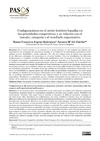Please use this identifier to cite or link to this item:
https://accedacris.ulpgc.es/jspui/handle/10553/41310
| Title: | Configuraciones en el sector hotelero basadas en las prioridades competitivas y su relación con el tamaño, categoría y el resultado organizativo | Other Titles: | Configurations in the hotel sector based on competitive priorities and their relationship with size, category and organizational performance | Authors: | Francisco Espino-Rodriguez, Tomas Gil-Padilla, Antonia M. |
UNESCO Clasification: | 531290 Economía sectorial: turismo | Keywords: | Taxonomy Competitive priorities Hotel Category Size, et al |
Issue Date: | 2017 | Journal: | Pasos: revista de turismo y patrimonio cultural | Abstract: | En el sector turístico y en concreto en el sector hotelero, no hay trabajos que definan una
taxonomía de las estrategias de operaciones basadas en el énfasis de las prioridades competitivas (coste,
calidad, servicio, flexibilidad y medio ambiente). Por ello este trabajo trata de definir una taxonomía
de las diferentes estrategias de operaciones en el sector hotelero. Una vez identificadas las diferentes
configuraciones, se establece si existen diferencias significativas entre los grupos de hoteles con respecto
al resultado organizativo, considerado desde su doble vertiente: financiera y no financiera. Por otra parte,
se analiza si la categoría hotelera puede determinar el tipo de configuración hotelera. Se ha analizado una
muestra representativa de hoteles (65 hoteles) de Gran Canaria por ser unos de los principales destinos para
los turistas europeos. Los resultados indican que existen tres grupos diferenciados de hoteles en función de
las prioridades competitivas. Un primer grupo que enfatiza las prioridades competitivas relacionadas con el
coste y la flexibilidad, un segundo grupo que enfatiza todas las prioridades competitivas y un tercer grupo
que enfatiza los objetivos de operaciones relacionados con la calidad y el servicio. Asimismo, se demuestra
que el resultado organizativo es diferente para algunos grupos de hoteles definidos por las prioridades
competitivas. Finalmente, se comprueba que las variables contextuales tienen relación con los grupos de
hoteles. Así la categoría y el tamaño tienen relación con las prioridades competitivas enfatizadas. In the tourism sector, and particularly in the hotel sector, no studies have defined a taxonomy of operations strategies based on emphasizing competitive priorities (cost, quality, service, flexibility and environment). Therefore, this paper tries to describe a taxonomy of different operations strategies in the hotel sector. After identifying the configurations, the study establishes whether there are significant differences between the hotel groups in their organizational performance, considered from two perspectives: financial and non-financial. Moreover, we analyze whether the hotel category and size can determine the type of hotel configuration. A representative sample of hotels (65 hotels) in Gran Canaria for being one of the major tourist destinations for European tourists is analyzed. The results indicate that there are three distinct groups of hotels based on competitive priorities. One group emphasizes competitive priorities related to cost and flexibility, a second group emphasizes all the competitive priorities, and a third group emphasizes goals related to quality and service operations. Results also show that the organizational performance is different for some hotel groups defined by competitive priorities. Finally, the findings show that contextual variables are related to groups of hotel, and that category and size are related to the competitive priorities emphasized. |
URI: | https://accedacris.ulpgc.es/handle/10553/41310 | ISSN: | 1695-7121 | DOI: | 10.25145/j.pasos.2017.15.013 | Source: | Pasos: revista de turismo y patrimonio cultural [ISSN 1695-7121], v. 15 (1), p. 211-228 |
| Appears in Collections: | Artículos |
WEB OF SCIENCETM
Citations
1
checked on Jun 8, 2025
Page view(s)
170
checked on Sep 27, 2025
Download(s)
260
checked on Sep 27, 2025
Google ScholarTM
Check
Altmetric
Share
Export metadata
Items in accedaCRIS are protected by copyright, with all rights reserved, unless otherwise indicated.
